Basic AI Chatbot Pricing: A simple chatbot that can answer questions about a product or service might cost around $10,000 to develop.
Read More
Inventory management focuses on monitoring detailed stock information, including orders and distributions. The best way to achieve this is to have the right quantities of the things, otherwise, the business may overstock its product lines or face an out-of-stock situation.
Beforehand, these operations were highly dependent on manual labor which was susceptible to human error, and slow response, amongst many other deficiencies.
With AI, inventory management has transformed, like its capability to predict demand, anticipate potential issues, and devise strategies for solving them. The machine-based program relies on data collection, analytics, and machine learning to pare down inventory and improve vehicle allocation.
AI-powered inventory management software has several key features that make it invaluable to businesses.
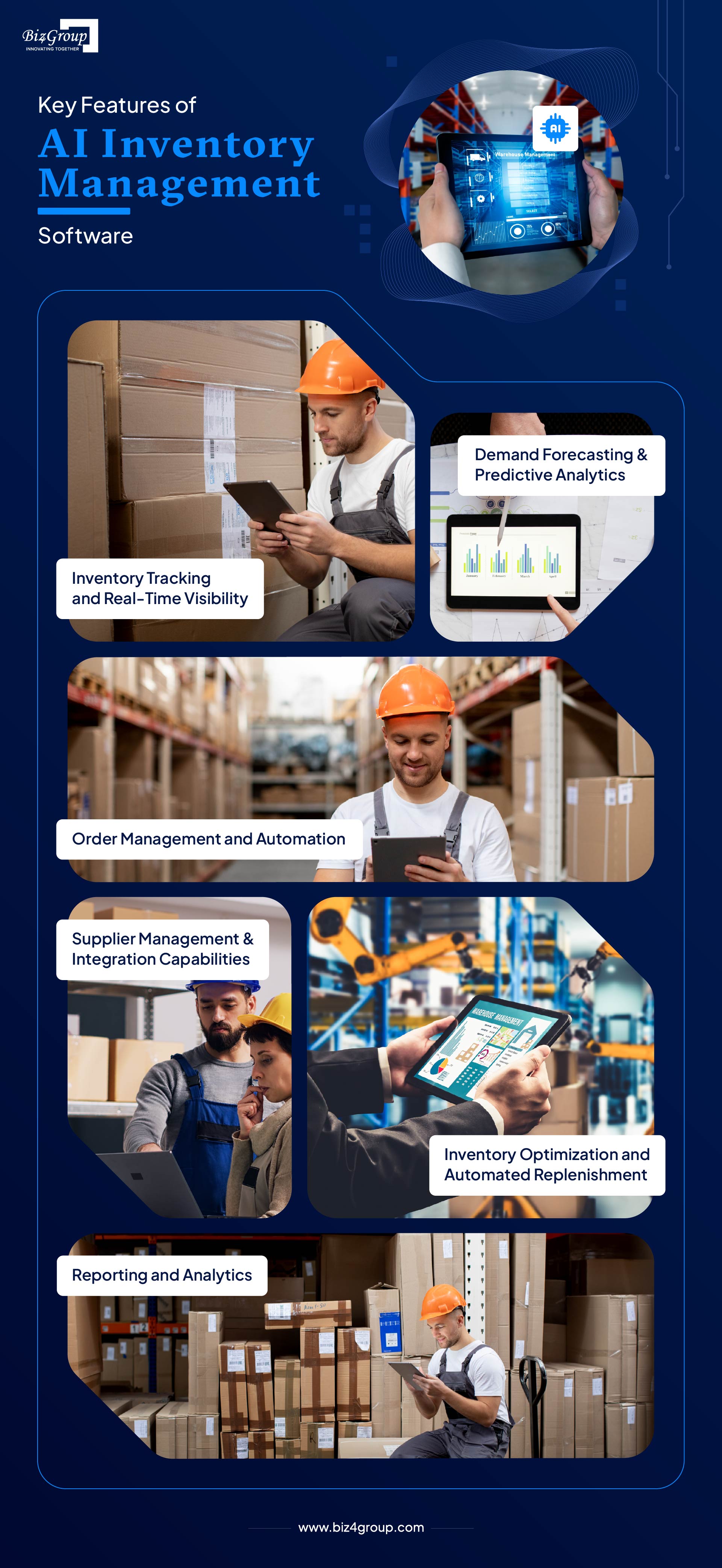
While collaborating with a generative AI development company, the software developed by them can monitor real-time tracking ensuring that there are recent data inputs on inventory quantity levels. Implemented in this regard is a feature that steers business entities to respond swiftly to demand changes, ultimately leading to products in the right amounts available.
With the help of generative AI for inventory management, the software can do more polished historical data research and generate future demand forecasts. It can learn from the conversations going on between the staff and suggest stock up requirements. This capability supplies businesses with the planning of inventory levels, which results in a reduced risk of overstocking or running out of goods.
AI-based inventory management software is designed to handle orders automatically so that human intervention can be kept to a minimum. It can automatically place orders in the instance of low stock level, preventing businesses from running out of the most important things.
The program operates with AI algorithms aimed at optimizing inventory levels which prevent purchase of excess stocks and reduce carrying cost. This optimization, with its result efficiency, can provide growth in productivity and cost savings.
By summarizing the inventory reports and analytics, businesses can grasp the hidden inventory patterns and make data-driven decisions. These findings lead to operational improvement and locate those areas that are worthwhile for further investigation.

Involving professional AI Development Services from the beginning is important for defining requirements, and implementing solutions that are scalable to meet business needs.
Developing AI inventory management software involves several key steps, from defining requirements to ongoing support, such as:
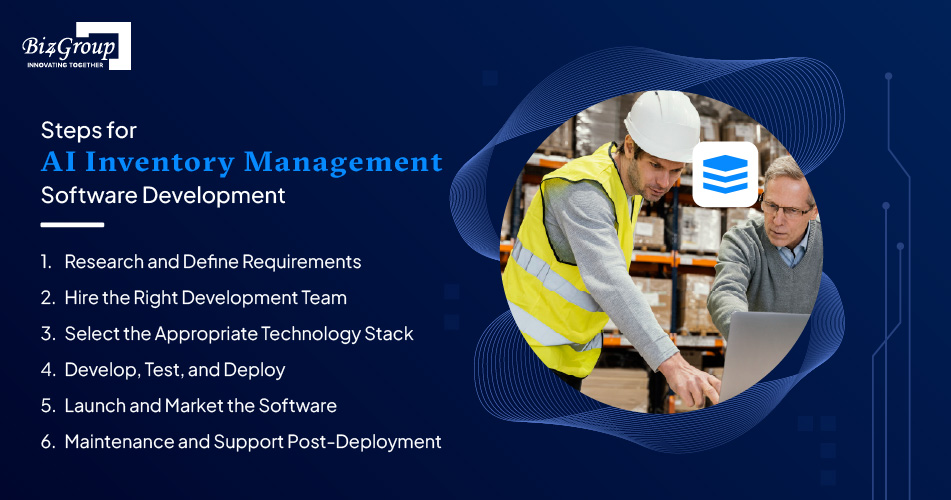
Firstly, understand the business requirements, then go for it. Identify what features are necessary for your software.
For example, ensure it performs real-time tracking, demand forecasting, or integrating suppliers. Conduct a study on already-existing products to find out what target consumers are missing and where opportunities are to make improvements.
Select an AI and inventory management-oriented software development company that has extensive experience. Make sure you choose a team with a proven track record and the ability to comprehend your type of business. A trusted development partner will guide you through the entire process; from planning to the implementation stage.
The technology stack may include the programming languages, frameworks, and tools that a software development team uses to craft their software. Your team will be examining various technology stacks for you depending on the scalability, security, and compatibility of the stack that you intend to use with other systems.
Development usually involves stable and scalable code that was designed following your requirements. Compliance is tested to check for proper software operations and quality. The tests may be conducted by performing different testing operations such as unit testing, integration testing, and user acceptance testing. The final step is the introduction of the software into your system after the testing is done.
After deployment, launch the software within your organization. Organize training for your staff which will embed comprehensive knowledge of AI inventory management software for internal use. This makes sure all people within the organization can convey the software's features and how to use them properly. Provide learning resources like guides, video lessons, and interactive tutorials to facilitate education.
Continuing measures and assistance play a key role in ensuring proper working of the software. This includes, among others, the items: bug fixes, software updates, and feature enhancements. Make sure your development team is always accessible and able to provide help in the event of any issues that arise post-launch.
Also Read: Biz4Group Named Among Top Software Development Companies in the USA in 2024 by Techreviewer.co
The use of AI in inventory management systems software has broad applications across various industries. Here are the use cases for the following:
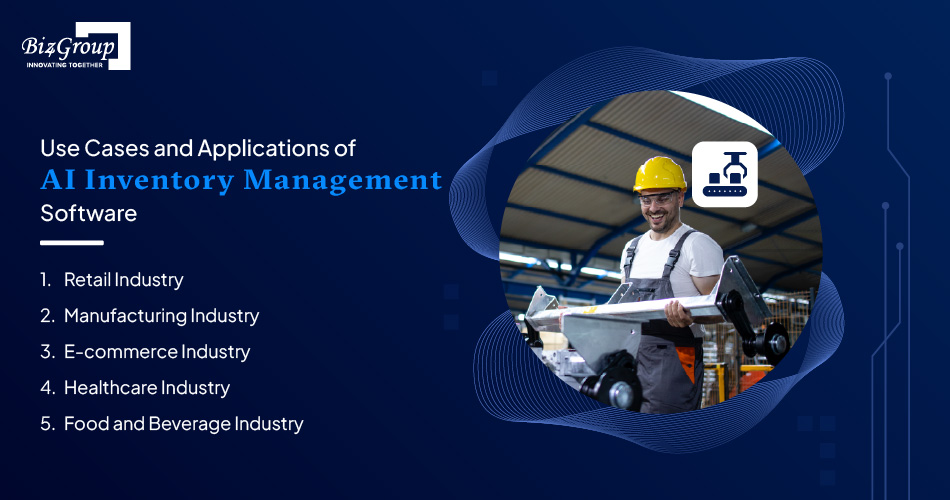
AI applications in retail inventory optimization facilitate stock level management, determine demand patterns, and initiate automatic shipments. It may be used to also enhance the customer experience by guaranteeing that frequently ordered items remain in stock. Through AI, retailers are finding it easy to manage overstocking and understocking and to cut down the waste.
AI is used by manufacturers for production planning, material management, and other related processes. The application of such software enables tracking of both raw materials and manufactured products, and it allows production processes to move on smoothly.
This can also help manufacturers predict demand for certain products and modify their production schedules for the products mentioned.
The e-commerce industry uses AI inventory management programs that help improve order fulfillment and warehouse automation. The software would be useful for the necessary task of handling large quantities of products, as well as the task of timely order processing. Furthermore, it can be integrated with shipping and logistics systems to facilitate the streamline of the delivery processes.
In healthcare, AI software is employed for managing medical inventory and tracking equipment. It also ensures having enough stock in hospitals and clinics of critical medical supplies, thus decreasing the risk of shortage. AI can also attend to keeping track of machinery usage and scheduling out their maintenance.
AI software used by the food and beverage industry helps manage perishable inventory and conforms to food safety regulations. The software can track the due date and recommend a suitable stock level to reduce wastage. It can further traceability too, by giving a tracing of handling and source of the food products.
Also Read: Biz4Group Ranked Among The Top 5 Software Development Companies In Florida By Techreviewer.co
While AI inventory management software offers many benefits, there are challenges and considerations to keep in mind.
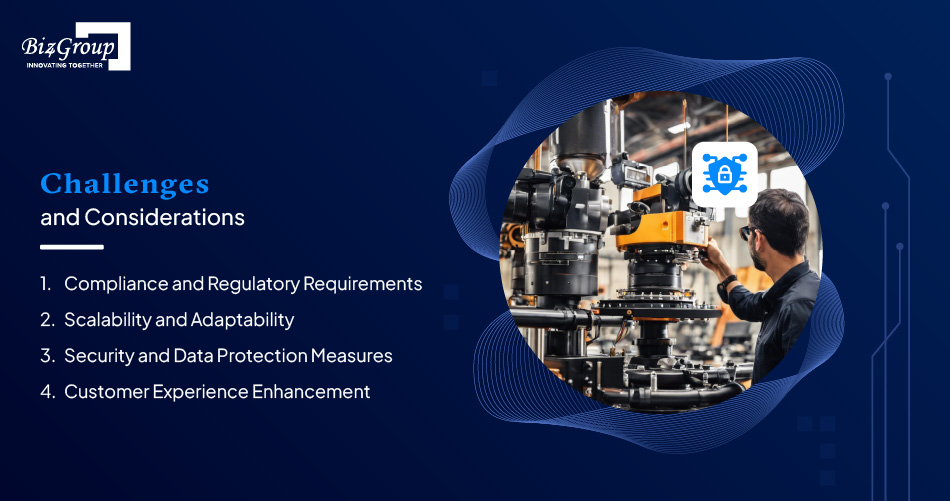
Depending on your industry, there may be strict rules governing inventory management, especially in sectors like healthcare, food, and manufacturing. To address this challenge, you need to ensure that your AI inventory management software meets all applicable regulations.
This might involve implementing specific safety measures, tracking requirements, or documentation processes. Compliance is crucial to avoid legal issues and maintain business operations without interruptions.
Scalability refers to the software's capacity to handle increased data volume, more complex processes, or additional users without performance degradation. Adaptability is also vital, ensuring the software can evolve with changing business needs or new technologies. To overcome this challenge, choose a flexible technology stack and work with developers who prioritize scalability in their design. This approach allows you to expand without worrying about software limitations.
Security is paramount when dealing with sensitive inventory data. AI inventory management software must have robust security measures to protect against unauthorized access, data breaches, and cyber threats. It requires implementing encryption, secure access controls, and regular security audits.
Additionally, compliance with data protection regulations, such as GDPR or CCPA, is essential to avoid penalties and maintain customer trust. Ensure your software provider has a strong security track record and offers ongoing support to address security vulnerabilities.
While customer experience might not seem directly related to inventory management, it plays a significant role in customer satisfaction. By ensuring products are always in stock and orders are processed quickly, businesses can ensure order fulfillment in no time. This challenge involves aligning your inventory management processes with customer expectations.
Features like automated reordering, real-time tracking, and efficient order fulfillment can enhance customer experience. To meet this challenge, consider customer feedback and adjust your inventory management practices to meet their needs.
Also Read: Generative AI Wealth Management Development: A Complete Guide
Whenever considering chatbot development services, it is important to account for the cost of deploying, developing, and maintaining them.
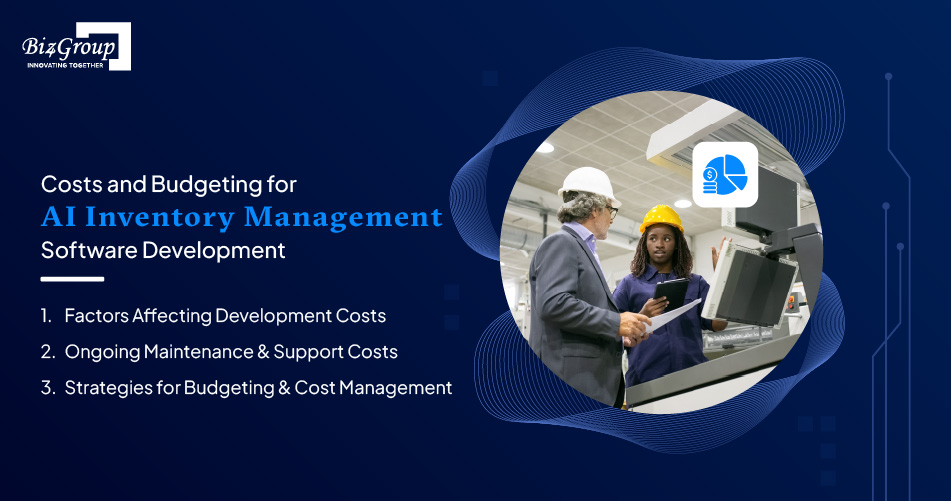
The development cost of AI inventory management software can vary widely based on several critical factors:
The complexity of the software and the level of customization required are major cost drivers. Complex algorithms for predictive analytics and custom integrations with existing systems can significantly increase development time and require specialized expertise.
The volume and variety of data that the software must handle can affect the cost. Larger datasets or the need for real-time data processing require more robust infrastructure and advanced data management capabilities, increasing the overall expense.
Developing an intuitive and engaging user interface can be resource-intensive but is crucial for user adoption and satisfaction. The cost will depend on the sophistication of the UI/UX design, and the interactivity required.
Adhering to industry-specific regulations and ensuring robust security can add to the development cost. Implementing advanced security protocols and compliance checks is essential but requires additional resources and expertise.

Sustaining the operation of AI inventory management software involves several ongoing expenses:
To keep up with technological advancements and industry trends, regular software updates and upgrades are necessary. These can include new features, security enhancements, and improvements in AI algorithms.
Providing continuous technical support is crucial to address any operational issues swiftly. This includes having a dedicated team available to solve problems and assist users, which adds to the operational costs.
Depending on whether the software is hosted on-premises or on the cloud, ongoing costs for server maintenance, cloud services, and data storage will apply. Cloud hosting often involves a subscription fee which varies based on data usage and network requirements.
Effective budgeting and cost control are key to the successful development and implementation of AI inventory management software:
Adopting a phased approach to software development can help manage costs better by spreading the expenditure over multiple stages. This approach allows for evaluating the impact of the software at each stage and adjusting the project scope and budget as necessary.
Choosing the right vendors and technology solutions can significantly impact costs. Compare different technologies and vendors to find the most cost-effective solutions that do not compromise on quality or capabilities.
Conduct a detailed ROI analysis to understand the financial benefits of the software relative to its cost. This analysis can help justify the investment and focus resources on features that offer the highest return.
Maintain flexibility in your budget to accommodate changes and unexpected needs during the development process. Regular budget reviews and updates can help manage costs effectively and ensure that the project stays on track financially.

AI inventory management software offers significant benefits for businesses, from real-time tracking to automated order management. By implementing AI software, businesses can improve efficiency, reduce costs, and enhance customer satisfaction. While there are challenges, careful planning, and a reliable development team can help overcome them. If you're considering AI inventory management software, focus on your specific business needs and choose a solution that aligns with your goals.
AI inventory management software uses artificial intelligence to automate and optimize inventory-related tasks. It combines real-time data tracking, predictive analytics, and machine learning to help businesses manage stock levels, forecast demand, and streamline order management.
Key benefits include improved accuracy in tracking inventory, reduced overstocking and understocking, automated order processing, enhanced demand forecasting, and better customer satisfaction through streamlined operations.
Yes, AI inventory management software can be tailored to the needs of small businesses. It helps automate repetitive tasks, reduces manual labor, and provides valuable insights for better inventory control, making it a cost-effective solution for businesses of all sizes.
Common security measures include encryption, secure user authentication, access controls, regular security audits, and compliance with data protection regulations. These measures ensure that sensitive inventory data is protected from unauthorized access and cyber threats.
with Biz4Group today!
Our website require some cookies to function properly. Read our privacy policy to know more.